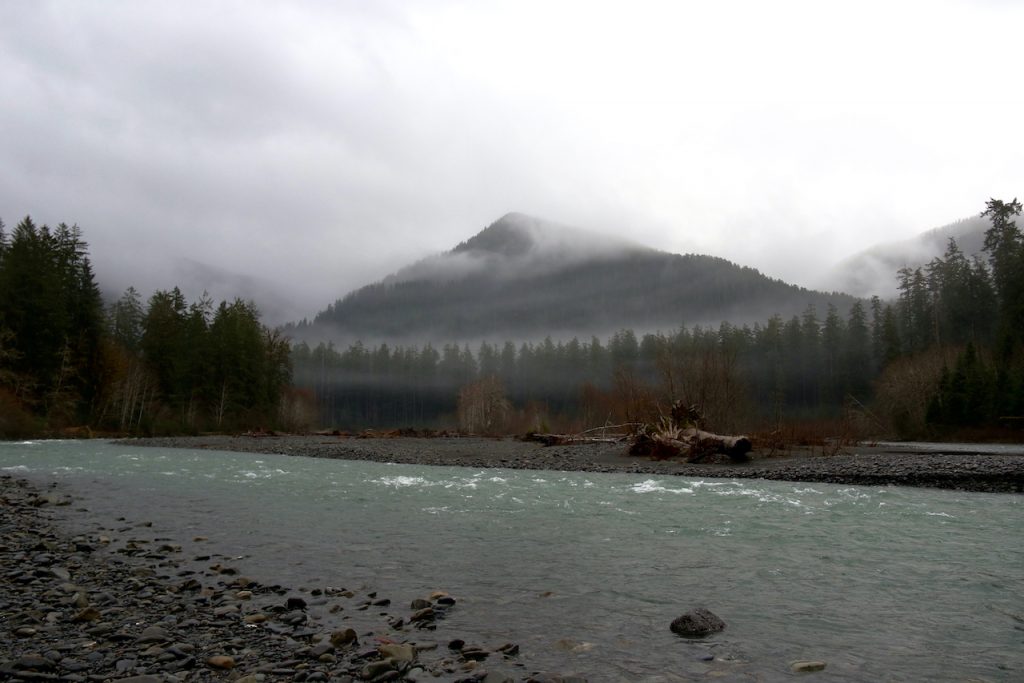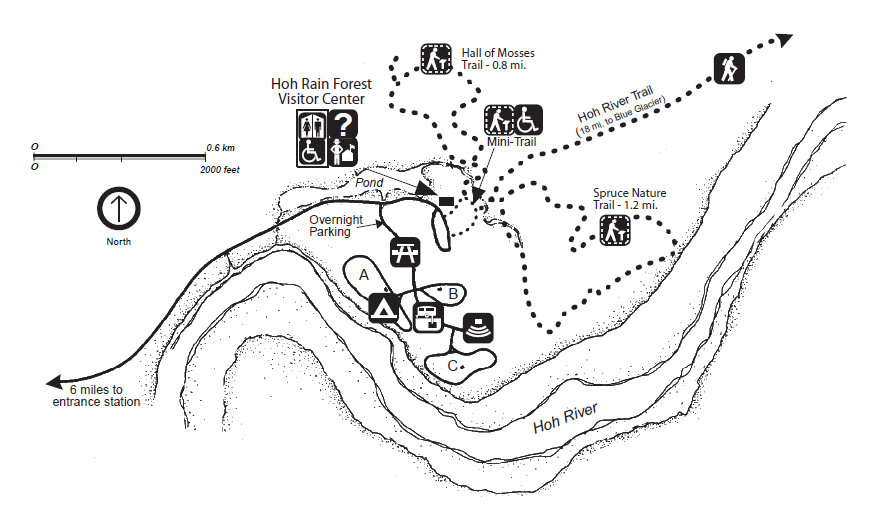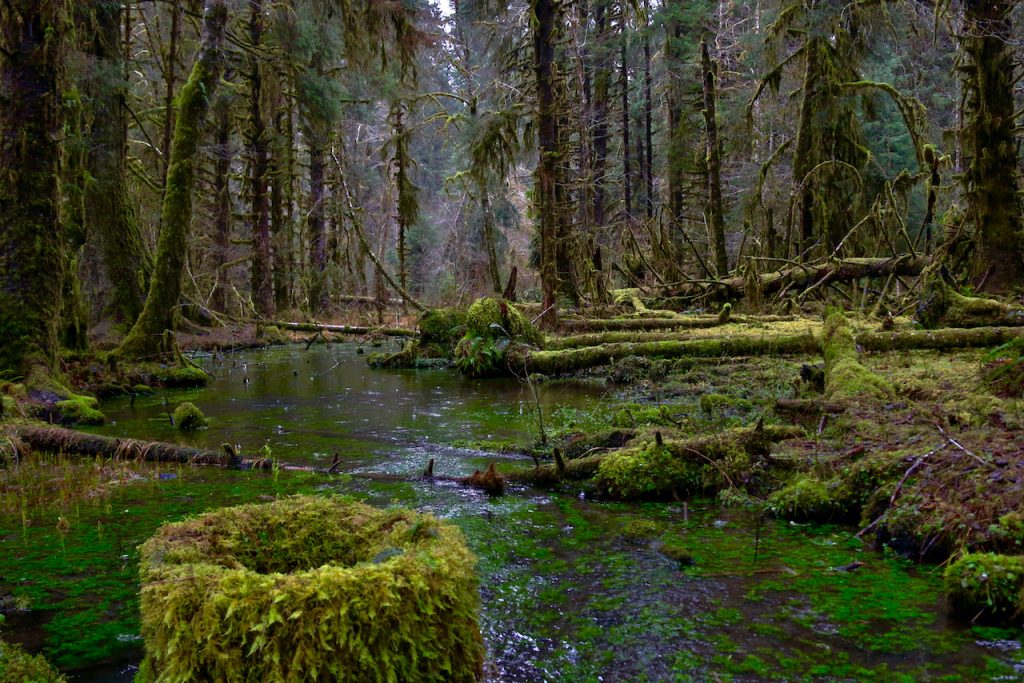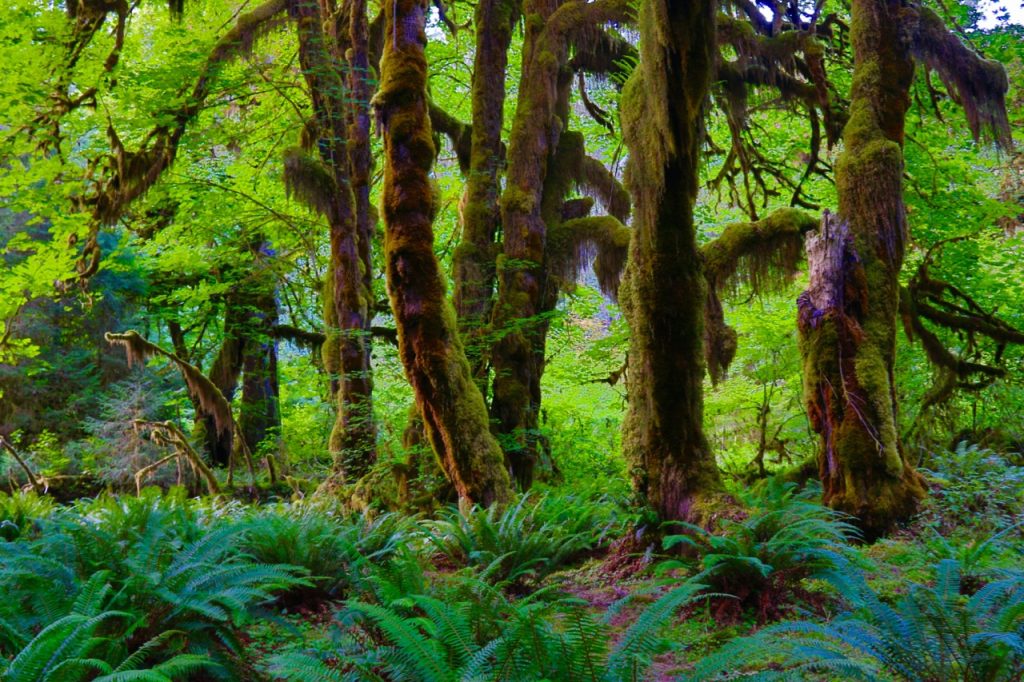Drenched with rain, impossibly green and dripping with moss, the Hoh Rainforest of Olympic National Park is one of the gems of America’s public lands. Gracing the covers of magazines in the 1900s and a constant presence on social media feeds, the Hoh is a must-visit wilderness destination for all styles of explorers.
From the Hoh, you can enjoy great day hikes, backpack to glaciers and alpine lakes, or camp amongst towering trees covered in moss. Located four hours from Seattle and a handful of miles downriver from the glaciated flanks of the mighty Mount Olympus, the emerald green Hoh Rainforest has been the ultimate gateway to Olympic’s wilderness for decades.
Navigation to Sections Of This Article:
Weather | Seasons | Camping | Hiking Trails | Backpacking | Hidden Gems | Other Activities
About The Hoh Rainforest
On the ancestral home of the Hoh Tribe, this land has been captivating the hearts and spirit of countless generations. Today, the Hoh Rainforest is one of the crown jewels of Olympic, full of breathtaking hiking trails, incredible forest and river views, as well as wildlife big and small. Visiting the Hoh is like stepping back in time, as the forests and terrain feel prehistoric, untouched just an inch from the edge of the roads and trails. The Hoh is drastically removed from the stresses of modern society and deep within the forest is the quietest spot in the contiguous United States. Those who find their way to the the Hoh will be rewarded with outdoor recreation unlike anywhere else in the world.
Weather
The Hoh Rainforest is tucked on the western side of the Olympic Mountains, where it catches the storms of the Pacific all year long. As the moisture-laden clouds get slowed by the glaciated peaks, 12 feet of rain falls in the region each year, most of which in just six months. Most of the Hoh Rainforest’s rain occurs from late October through April, with November typically the wettest month. During the rainy season, the trails will be muddy and clouds appear to rest in the trees. Water is everywhere, giving the rainforest the moisture it needs to be a wilderness paradise. Any time of the year, expect and be prepared for rain while exploring the Hoh. July is the driest month in the Hoh and in recent years, the area has been under drought conditions. If it does rain on your visit, rejoice at the fact that you are seeing the rainforest in its natural state!

A rainy day along the Hoh River in Olympic National Park.
Seasonal Highlights – Best Times To Visit Hoh National Forest
Summer: While it is known around the world, the Hoh Rainforest is just the 4th most visited region in the park, meaning that you may encounter far fewer people here than other popular areas in Olympic. The summer months are obviously the busiest, as the weather is the nicest and the rain is the least, but the masses are easily escapable with only a few miles of hiking. The summer months also have the least amount of animal sightings close to the infrastructure of the region, but elk and deer are frequently seen just a few miles up the Hoh River Trail.
Fall: Once September rolls around, the crowds thin and the temperatures drop. Fall is a fantastic time to visit, as bugling elk looking to mate roam the trails and campgrounds. Occasionally, the campground will be closed due to aggressive behavior by the elk. Toward the end of the fall, returning salmon make their way upriver, spawning in the creeks of the rainforest. During this time, lucky hikers may also see bobcat fishing along the shoreline. You’ll also have a few splashes of fall colors in the rainforest during this time, as the maples throughout the forest will have their huge leaves turn and fall to the forest floor.
Winter: As winter sets in, the rainforest becomes truly rainy, with clouds resting on the mountains and water all over. This is when the forest drips nonstop. If you visit during the fall and winter, you’ll definitely need a rain jacket, rain pants and maybe even a pair boots to get around. This is one of the few places in Washington where umbrella use on hikes is recommended. Occasionally, it will snow in the Hoh, but not often enough to be reliable. Do bring traction devices for mud and snow in the winter and spring months. You may not need them, but it is better to have them and not need them, then need them and not have them.
Spring: Once spring starts, the snows in the mountains melt and the river rises. Elk make their way up river and warmth returns to the forest, as does access to the higher elevation sections of the trails. Spring also brings an explosion of mushrooms and wildflowers in the rainforest. While the wildflowers won’t be as intense and widespread as those found in the higher elevations, the whites and pinks starkly standout against the dense greens of the forest. Keep an eye and nose out for skunk cabbage along the trails in April, May and June. If you think you smell a skunk, it is probably the plant in bloom.
Camping in the Hoh
Open year round, a night or two at the Hoh Campground is one of the best ways to experience the rainforest. Currently, reservations are not taken at the campground, making every site first come, first served. In the summer, it can fill up on weekends, so plan ahead. Once you have a site, you’ll be a short distance from the river and from the trails. Camping here is the ideal basecamp for full day treks, lazy days and everything in between. At the campground, there are 88 sites, most of which are RV friendly for vehicles up to 21’ in length. You’ll also have access to flushing toilets and running water, amenities not found at every Olympic campground.
Along the trails, five backcountry camping areas are also available year round along the Hoh River Trail. For those hoping for a great basecamp in the wilderness along the Hoh, consider a stay at the Olympus Ranger Station camping area, 9.7 miles from the visitor center. From here, you are an 8 mile hike up to Seven Lakes Basin, or 7.7 miles from Blue Glacier on the flanks of Mount Olympus. Permits are required for backpackers heading to the sites around Mount Olympus and the Seven Lakes Basin region. Hiking to either destination does make for a long day, but those destinations are two of the best experiences you may ever have in National Parks.
Hiking Trails in the Hoh

Trail Map of the Hoh Rainforest from NPS
Hall of Mosses Trail
Distance: 0.8 miles
Difficulty: Easy
From the Hoh Rainforest Visitor Center, there are three main hikes from which you can choose. The first, and arguably most famous, is the Hall of Mosses Trail. The Hall of Mosses Trail is only eight-tenths of a mile with 500 feet of elevation gain, but is easy enough for both young and old. Along the Hall of Mosses Trail, you’ll pass through a maple grove that has trees weighed down by hundreds of pounds of moss, over creeks full of green grasses drifting in the current, and past fallen giants giving life to future generations of rain forest. This short trail is perfect for starting your exploration of the rainforests of Olympic National Park.
Spruce Nature Trail
Distance: 1.2 Miles
Difficulty: Easy
After walking the Hall of Mosses, head over to the Spruce Nature Trail. This trail is slightly less popular, but full of stunning scenes. The 1.2 mile loop trail provides even more unique rainforest beauty, with small creeks surrounded by mossy trees and ferns, as well as a chance to stand on the banks of the mighty Hoh River. During the fall months, this trail provides excellent opportunities to see eagles, salmon, and elk, as well as a forest floor covered with colorful mushrooms.
Hoh River Trail
Distance: 1-20 Miles One Way
Difficulty: Easy to Moderate
The longer day hike out of the Hoh Visitor Center is along the Hoh River Trail to Five Mile Island. The Hoh River Trail runs for 20 miles up to the glaciers of Mount Olympus, but most will hike five miles out along this scenic trail. Mostly flat and passing next to towering trees with ferns in all directions and the occasional river views, hiking to Five Mile gives you the perfect taste of the Olympic wilderness without having to backpack. You may even encounter an elk herd and bald eagles.

A rainy day in the Hoh Rainforest of Olympic National Park.
Backpacking Trips
Those longing that perfect backcountry trip will love the Hoh Rainforest. From the Hoh River Trail, a few of the best adventures one can have are possible. If you are craving an epic and challenging trek, hiking up to the glaciers of Mount Olympus through the rainforest is hard to beat. Summiting the mountain requires mountaineering experience, but backpackers of almost any level can get to Glacier Meadows and take in the stunning sights at Blue Glacier in the summer and early fall months.
Seven Lakes Basin is a loop hike that is roughly 18 miles in length, after hiking up 13.3 miles from the Hoh River trailhead. That is a long, but gorgeous and memorable 31 miles. After wandering amongst the ferns, mosses and towering timbers, the trail climbs to high alpine lakes that give breathtaking mountain views, wildlife sights and bucket list camping spots. This area is considered to be one of the quintessential backpacking trips in Olympic, so permits are required to camp here during the summer months.
Hidden Gems
Along the Hoh River Trail, one of the lesser known gems for the roughly 400,000 people who explore the Hoh each year is Mineral Creek Falls. Found just 2.5 miles upriver from the visitor center and parking lot, this waterfall is found along the Hoh River Trail. Moss-covered maples flanking the trail, as well as endless ferns next to the milky blue waters of the Hoh River make this hike gorgeous year round. Wooden bridges span small streams and the occasional view of the mountains leading to Mount Olympus peek through the rainforest canopy. This walk becomes a step back in time with every passing mile. At the wooden bridge around 2.5 miles in, look left and see the picturesque falls plunging through the ferns and tall trees.
Amenities and Activities
Outside of the park boundaries, you’ll find small shops along the road back to Forks, Washington. In and out of town, you’ll enjoy visiting the hiking and fishing guides, small museums, quirky shops, restaurants, grocery stores and gas stations. Forks has many amenities, but no chain stores or chain restaurants. Pick a spot and explore, as each destination is unique and a true representation of life on the Olympic Peninsula. The towns and stores, like the forest, are timeless and worth the visit. In town and in the Hoh, you’ll meet great people, hear and experience interesting stories and come back with a love for this corner of the Olympic Peninsula. After exploring the Hoh Rainforest and the town of Forks, head to the coastal town of LaPush to see the sea stacks and wild coast of Olympic National Park.

Endless wilderness greets those who explore the Hoh Rainforest of Olympic National Park.
Douglas Scott is nationally recognized outdoors writer, with works appearing in publications all over the country. Born and raised in both the Pacific Northwest and Rocky Mountains, his passion for the wilderness of the west spills into everything he does. He is a trail runner, avid hiker and guidebook author, focusing on the Public Lands of America’s West. Douglas strives to share his experiences with like-minded modern adventurers hoping to get to know their own backyards a little better. If there is a question about nature, chances are that Doug will know the answer and a few other quirky and important facts about the region. Check out more of his work, and pick up a guidebook at outdoor-society.com.
